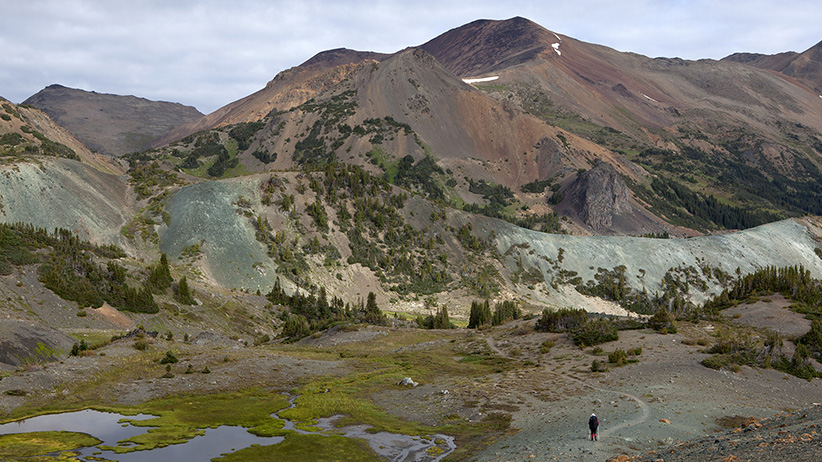This land is now their land, and it always was
Colby Cosh on the Supreme Court decision in Tsilhqot’in Nation v. British Columbia
Hiker on trail below Camel Pass, Nea Peak and Eldorado Mountain in the distance, Southern Chilcotins, British Columbia, Canada. Photo – Karen Crowe/Getty
Share

Like everyone else who has studied the Supreme Court’s dramatic decision in the case of Tsilhqot’in Nation v. British Columbia, my response largely amounts to “Well, sure.” “Tsilhqot’in” is the new accepted name of the small confederacy of B.C. Indian bands long called the Chilcotin in English. They live in a scarcely accessible part of the province, and one reason it is scarcely accessible is that the Chilcotin prefer it that way. In 1864, they fought a brief “war” against white road builders, killing a dozen or so. The leaders of the uprising were inveigled into surrendering and appearing before the “Hanging Judge,” Matthew Begbie. True to his nickname, he executed five of the rebels. But that road never got finished.
In most of Canada, occupancy by “settlers” whose ancestors arrived after Columbus has been formally arranged under explicit treaties. There is a lot of arguing going on about the interpretation of these treaties. But, broadly speaking, most of us white folks outside B.C. have permission to be here. Our arrival, our multiplication and the supremacy of our legal system were all explicitly foreseen and consented to by representatives of the land’s Aboriginal occupants. The European signatories of those treaties recognized that First Nations had some sort of property right whose extinction needed to be negotiated.
Oddly, this concept was clearer to imperial authorities in the 18th and early 19th centuries than to those who came later. The Royal Proclamation of 1763, for instance, recognized the right of Indians to dispose of their own lands only when they saw fit. By the time mass colonization was under way in British Columbia, the men in charge on the scene had absorbed different ideas. Concepts of racial struggle were in vogue, and so were straitlaced, monolithic models of human progress.
It seems possible that British administrators had come to despise communal forms of land use that had only recently been extirpated in the old country. The Supreme Court still refers to the Chilcotin as “semi-nomadic” because they lived in villages surrounded by ground held in common for the purpose of fishing, hunting and wandering about. Were the people of the Scottish Highlands or the Forest of Dean semi-nomads? The part of Saskatchewan where my uncle raises cattle still has some communal pasture; seeing as he also spends a good 250 days a year away on business, perhaps the Coshes are semi-nomadic, too.
In 1870, B.C. land commissioner Joseph Trutch, who would soon become the province’s first lieutenant-governor, famously wrote that “the Indians have really no rights to the lands they claim, nor are they of any actual value or utility to them.” This was the principle on which B.C. was settled by Europeans. It took a hundred years for the courts to start noticing that most of the province had never been formally ceded, and to start asking whether this meant B.C. Indians might have surviving rights. Chief Justice Beverley McLachlin notes in her decision that “from the Tsilhqot’in perspective, the land has always been theirs.” With due respect, this seems like an unarguable fact rather than a “perspective.”
The Tsilhqot’in Nation suit marks the first time the Supreme Court has bestowed “Aboriginal title” on a particular patch of land, but everyone in B.C. saw the day coming. Some hoped to expiate British Columbia’s original sin through cheap gestures—such as referring to the Chilcotin as the “Tsilhqot’in,” on the apparent premise that the language of the invader cannot be permitted its own terminology. Non-Aboriginal British Columbians’ awareness of being uninvited guests may actually account, in part, for their ostentatious hippie character. If you’ve torn a chunk off Mother Earth, it probably eases your mind to convince yourself you are obeying a higher law.
The biggest problem for large infrastructure projects in the B.C. Interior may not be the collective nature of “Aboriginal title” alone, but the fact that it is restricted in a way ordinary property ownership isn’t. “It is collective title,” writes the chief justice, “held not only for the present generation but for all succeeding generations. This means it cannot be alienated except to the Crown, or encumbered in ways that would prevent future generations of the group from using and enjoying it.” The special category of legal title devised for First Nations turns out to have a downside: Even completely unanimous approval of some land use by a band or nation may not suffice if people who do not yet exist are imagined disagreeing with it. Would you care to own a car or a house on such terms?